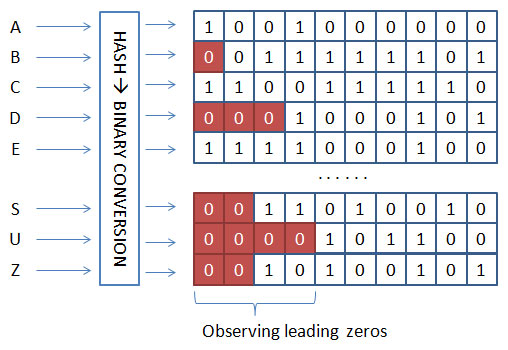How To Find The Number Of Elements In A Set
Knowing the singled-out number of objects is useful in various situations, such as when you want to know how many distinct users have seen a certain website page or the number of singled-out search engine queries. Storing all the elements and finding the duplicates amidst them can't work with millions of elements, especially coming from a stream. When you want to know the number of distinct objects in a stream, you nevertheless have to rely on a hash function, simply the approach involves taking a numeric sketch.
Sketching means taking an approximation, that is an inexact yet not completely wrong value as an answer. Approximation is adequate considering the existent value is non also far from it. In this smart algorithm, HyperLogLog, which is based on probability and approximation, y'all observe the characteristics of numbers generated from the stream. HyperLogLog derives from the studies of estimator scientists Nigel Martin and Philippe Flajolet. Flajolet improved their initial algorithm, Flajolet–Martin (or the LogLog algorithm), into the more than robust HyperLogLog version, which works similar this:
- A hash converts every element received from the stream into a number.
- The algorithm converts the number into binary, the base ii numeric standard that computers use.
- The algorithm counts the number of initial zeros in the binary number and tracks of the maximum number it sees, which is north.
- The algorithm estimates the number of distinct elements passed in the stream using northward. The number of distinct elements is ii^northward.

Counting only leading zeros.
The trick of the algorithm is that if your hash is producing random results, equally distributed (as in a Bloom filter), past looking at the binary representation, you can calculate the probability that a sequence of zeros appeared. Because the probability of a single binary number to be 0 is one in 2, for calculating the probability of sequences of zeros, you lot just multiply that one/ii probability as many times as the length of the sequence of zeros:
- 50 percentage (one/2) probability for numbers starting with 0
- 25 percent (ane/2 * one/two ) probability for numbers starting with 00
- 12.5 percent (i/ii * ane/2 * i/2) probability for numbers starting with 000
- (1/2)^1000 probability for numbers starting with k zeros (you use powers for faster calculations of many multiplications of the aforementioned number)
The fewer the numbers that HyperLogLog sees, the greater the imprecision. Accuracy increases when you use the HyperLogLog adding many times using different hash functions and average together the answers from each calculation, but hashing many times takes fourth dimension, and streams are fast. As an alternative, yous tin can use the same hash simply separate the stream into groups (such every bit by separating the elements into groups as they arrive based on their inflow club) and for each group, you proceed track of the maximum number of abaft zeros. In the finish, you compute the distinct element estimate for each group and compute the arithmetic average of all the estimates. This arroyo is stochastic averaging and provides more than precise estimates than applying the algorithm to the entire stream.
About This Commodity
This article is from the volume:
- Algorithms For Dummies ,
This commodity tin be found in the category:
- General (Data Science) ,
How To Find The Number Of Elements In A Set,
Source: https://www.dummies.com/article/technology/information-technology/data-science/general-data-science/find-number-elements-data-stream-242486/
Posted by: rigginsglond1944.blogspot.com


0 Response to "How To Find The Number Of Elements In A Set"
Post a Comment